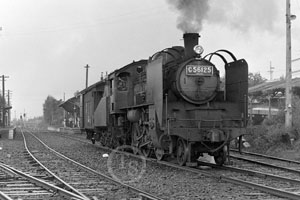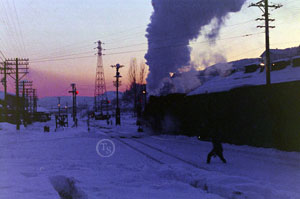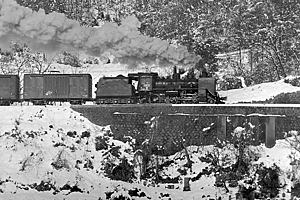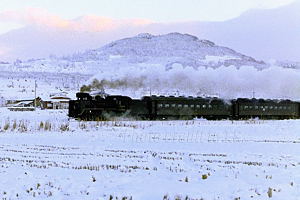
C56 No.130
Night view at Nagano depot.
During Dec 1970.
Japanese
|
1934 - 1974 A small to middle sized light Tender-Engine for light grade lines. |

C56 No.130 Night view at Nagano depot. During Dec 1970. |
|
Class C56 is the same as C12, which was planned for "Very Light Grade Line" service.
When the C12 was first used, it was used on shorter runs,
but as longer runs came into being which required greater coal and water capacity ...the C56 was introduced.
Therefore, when connected as a tender and with an axle arrangement of 2-6-0, the C12 was similar to the class C56.
In regard to overall engine performance, it was totally the same as the C12. The tender's sides were removed for improved vision during operation. This assumes that if turntable service was not available, the backing up of engines was facilitated. The first C56 was manufactured at the Hitachi Co. it's manufactured number was 622. C56_1 worked on the Hidaka line, but she was transferred to Burma during September 1941 and lost after WW2. The C56 was manufactured from 1934 with a total number of 160 (*) engines. They were mainly concentrated on long distance light lines. Those lines were, Hidaka, Koumi, Echigo, Kisuki and Yamano lines. (* JGR - 160, Karafuto R.- 4, Private R.-1 Total - 165)
During 1942, four C56s were ordered from Karafuto Railway (currently South-Sakhalin in Russian territory) as Karafuto Railway's Class C52 No.1 - 4. When the Karafuto railway was integrated with the Japanese government railway during 1943, they were transferred to the JGR and renumbered with the ensuing JGR C56's No. 161 - 164. During October 1944, two C56s (No.103 and 152) were transferred from the Japanese mainland to the Karafuto Railway. Karafuto Railway ordered four and transferred two, for a total of six C56s and were condemned by the Soviet Union when the war was over. C56 attracted attention from the military, as a war area small sized tender model. Therefore, more than half of the engines No.1 - 90 were done in narrow gauge (1067mm->1000mm), and 47 were transferred to Thailand and 43 were transferred to Burma from Japan during November and December 1941. They were used for railway construction, besides main line operations. Among their operations, the ' Thaimen Railway ' construction especially stood out. The Thaimen railway ran between Burma and Thailand, and was constructed by the Japanese military, utilizing forced labor from captured prisoners of war under brutal working conditions. That construction was made famous in the movie, ' The Bridge on the River Kwai '.
With the exception of 90 which were moved out to Thailand, Burma, and 6 of which were moved out to Karafuto, a total of 68 C56s were still active all over Japanese local lines after WW2. The surviving 68 engines were active until 1959. However, the culling of C56's began in 1960, and were decreased to 16 during 1973. They were ; 3 in the Nagano depot (No.94, 96 and 131) .... Out of service, (Iiyama line service closed Sep 1972) 1 in the Nakagomi depot (No.150) .... Out of service, (Koumi line service closed Dec 1972) 4 in the Nanao depot (No.97, 123, 124, and 159) for the Nanao line, 4 in the Hamada depot (No.98, 108, 126 and 131) for the Northern-Sanko line, 3 in the Yoshimatsu depot (No.91, 111 and 135) for yard works, 1 in the Miyazaki depot (No.92) .... Out of service. (Tsuma line service closed Mar 1972) Finally, their last appearance consisted of three at Hamada depot (No.126, 131 and 150), and at the Kiso-Fukushima depot (No.124, moved from Nanao depot) during November 1974. |
| Primary ran line in last 10 years |
Hidaka, Iiyama, Koumi, Nanao, Oito, Sanko-Hoku, Tuma, Yamano and Miyanojyo line
| Last line/depot and year |
Sanko-Hoku line / Hamada,
Kiso-Fukushima depot 1974
| Restored engine (2017) |
2 (No.44, 160)
| Preserved engine (2017) |
20 (Japan)
| |

|

| ||||||||
|
C56 is seen here in a heavy snowfall region of Nagano, steaming under blue winter skies. Iiyama Feb 1970. |
C56 No.125 leaves Japan's highest point, 1345 meters, near Mt.Yatugatake, from Nobeyama station. C56 was nicknamed "Pony" because of its smaller size.
| 
| 
Lingering twilight on winters snow contrasts | with darkness as C56 No.96 leaves Iiyama station on Iiyama line. Dec 1971. C56_131
Kamizakai, Iyama line, Feb 1970. |
| 
| 
C56_150 pulling the "Vegetable Train", | Kiyosato on the Koumi line Sept 1971. C56_130
Kaesa at Iyama line. | Dec 1971. |

| Configuration | 2-6-0 | Dimensions Length (mm) | 14325 |
| Engine Weight (Operating tons) | 37.6 | Driver size (mm diameter) | 1400 |
| Boiler pressure (Kg/cm2) | 14.0 | Max Tractive effort (tons) | 8.0 |
| Driver Max Power (PS) | 505 | Max Speed (km/h) | 75 |
| Manufactured years | 1934-1939 | Total production | 160 |
| Number of moved out to other countries in WW2 with gauge remodeling. | 96 | Gauge | 3ft 6in (1067mm) |
Introduction |
Go to Top |